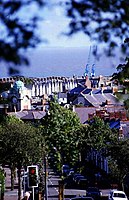Barry (Wales)
|
Barry Welsh Y Barri |
||
|---|---|---|
| Coordinates | 51 ° 24 ′ N , 3 ° 16 ′ W | |
|
|
||
| Residents | 47,863 (2001) | |
| administration | ||
| Post town | BARRY | |
| ZIP code section | CF62-63 | |
| prefix | 01446 | |
| Part of the country | Wales | |
| Preserved County | South Glamorgan | |
| Unitary authority | Vale of Glamorgan | |
| British Parliament | Vale of Glamorgan | |
| Welsh Parliament | Vale of Glamorgan | |
Barry ( Welsh Y Barri ) is a town in the Vale of Glamorgan county in Wales, not far from Cardiff . Barry is the administrative seat of the county. It is on the Bristol Channel and is the southernmost city of Wales. Barry is a seaside resort with a beach and an amusement park, the Barry Island Pleasure Park. In 2001 the city had 47,863 inhabitants.
history
The name of the city is derived from St. Baruc (Welsh: Barrwg), who drowned in the Bristol Channel in the 6th century and was buried in Barry. The village of Cadoxton, which today belongs to Barry, also takes its name from an early missionary, Cadoc, the teacher of Baruc. The medieval church of St. Cadoc in Cadoxton is still preserved today. At the end of the 11th century, the Norman knight Odo Barry Castle built, and his family named themselves de Barri after the castle . Barry remained a tranquil fishing village for a long time until a coal port was built here in the 1880s, which was used to ship the coal extracted from the South Wales mines. This new port relieved the neighboring Tiger Bay; Construction began in 1884 and the first port basin was inaugurated in 1889. This was followed by two more docks and a number of docks, as well as a Barry Railway Company railway line. In 1903 the amount of coal shipped was already over 9 million tons and in 1913 Barry was the largest coal export port in the world. At the same time as the port was expanded, the city continued to expand, so that the towns of Cadoxton and Barry Island were soon incorporated.
economy
The port still plays an important role in the life of the city today. Barry has also become an important production site and service center for the Vale of Glamorgan. The port facilities were given a direct road connection to the M4 motorway with the construction of Docks Link Road in 1981. The port itself can supply ships up to 23,000 tons; Barry's location on the Severn Estuary also allows deep-water ships to call at the port.
Most of the city's industrial operations are concentrated around the port. The most important chemical companies include Cabot Carbon and Dow Corning (with the largest silicone factory in Europe). Other important employers are Jewson Builders' Merchants, Western Welding and Engineering, Bumnelly, as well as Rank Hovis and the port operator Associated British Ports.
Barry is a traditional Labor stronghold that holds a majority on the city council.
traffic
From the mid-1960s, Barry station served as the British Railway's "steam locomotive graveyard" for Greater Wales. From here, according to a BBC documentary, many British museum railways moved their steam locomotives because Wales was a refuge for small, local and branch lines.
Sports
Barry became internationally known in the 1990s through the Barry Town United football club , which won eight Welsh championship titles and won several European Cup games.
Personalities
From Barry:
- Grace Williams , composer (1906–1977)
- Glyn Daniel , archaeologist (1914–1986)
- Derek Tapscott , football player (1932-2008)
- Robert Tear , opera singer (1939-2011)
- Damian Green , politician (* 1956)
- Julia Gillard , Australian politician (* 1961)
- Alastair Reynolds , science fiction author (born 1966)
- Stephen Dodd , golf professional (born 1966)
Web links
Individual evidence
- ^ Castles uncovered: Barry Castle. Retrieved August 19, 2015 .
- ↑ https://www.youtube.com/watch?v=PWn4qkfPbd0

